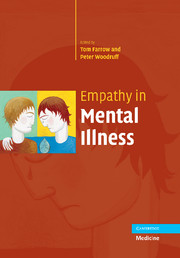Book contents
- Frontmatter
- Contents
- Foreword
- List of contributors
- Part I ‘Dysempathy’ in psychiatric samples
- Part II Empathy and related concepts in health
- 9 Neonatal antecedents for empathy
- 10 The evolutionary neurobiology, emergence and facilitation of empathy
- 11 Naturally occurring variability in state empathy
- 12 Neuroimaging of empathy
- 13 The neurophysiology of empathy
- 14 The cognitive neuropsychology of empathy
- 15 The genetics of empathy and its disorders
- 16 Empathogenic agents: their use, abuse, mechanism of action and addiction potential
- 17 Existential empathy: the intimacy of self and other
- 18 Empathizing and systemizing in males, females and autism: a test of the neural competition theory
- 19 Motivational-affective processing and the neural foundations of empathy
- 20 Face processing and empathy
- Part III Empathy models, regulation and measurement of empathy
- Index
19 - Motivational-affective processing and the neural foundations of empathy
from Part II - Empathy and related concepts in health
Published online by Cambridge University Press: 17 August 2009
- Frontmatter
- Contents
- Foreword
- List of contributors
- Part I ‘Dysempathy’ in psychiatric samples
- Part II Empathy and related concepts in health
- 9 Neonatal antecedents for empathy
- 10 The evolutionary neurobiology, emergence and facilitation of empathy
- 11 Naturally occurring variability in state empathy
- 12 Neuroimaging of empathy
- 13 The neurophysiology of empathy
- 14 The cognitive neuropsychology of empathy
- 15 The genetics of empathy and its disorders
- 16 Empathogenic agents: their use, abuse, mechanism of action and addiction potential
- 17 Existential empathy: the intimacy of self and other
- 18 Empathizing and systemizing in males, females and autism: a test of the neural competition theory
- 19 Motivational-affective processing and the neural foundations of empathy
- 20 Face processing and empathy
- Part III Empathy models, regulation and measurement of empathy
- Index
Summary
… Candace, howling oh-my-God-oh-my-God, holds up her hand, which is gushing blood from a deep gash that extends from her thumbnail almost to her palm. The blood is everywhere – down her arm, in the elaborate grooves she's been carving in the back of her chair … Looking at all the blood, Tick feels her own left arm begin to throb the way it always does in anticipation of hypodermic needles at the doctor's office, and at horror movies when somebody gets slashed.
Richard Russo, Empire FallsIntroduction
Pleasure and pain, comfort and discomfort, hot and cold – we are creatures for whom states of affairs are imbued with goodness or badness. When they are bad, we experience the need to avoid or terminate the experience. Sometimes, like the character Tick in the quote above, we feel comparable subjective sensations when we see someone else in aversive circumstances, even though we ourselves might be quite safe from them.
Recent research hints that we, as body owners, perceive even the actions and sensations of other people through a ‘filter’ of our own bodily representations. Visual information about the goal-directed actions of others can engage action-preparation pathways in the brains of passive observers (di Pellegrino et al., 1992; Gallese et al., 1996; Rizzolatti et al., 1996).
Information
- Type
- Chapter
- Information
- Empathy in Mental Illness , pp. 335 - 359Publisher: Cambridge University PressPrint publication year: 2007
Accessibility standard: Unknown
- 2
- Cited by
